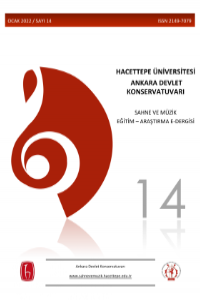BARTÓK’UN GECENİN MÜZİĞİ ADLI ESERİNDE PASTORAL TEMALARIN PİYANODA NASIL YANSITILDIĞINA DAİR BİR İNCELEME
‘Gece müziği’, Macar besteci, piyanist ve etnomüzikolog Béla Bartók’un olgunluk döneminde piyano, oda müziği ve orkestra kompozisyonlarının çoğunlukla yavaş tempodaki bölümleriyle ilişkilendirilen bir müzik stilidir. Adını, bestecinin 1926 yılında bestelediği “Açık Havada” [Out (of) Doors] adlı piyano süitinin dördüncü parçasına verdiği “Gecenin Müziği” (The Night’s Music) başlığından alan bu stil, genel itibarıyla bu karanlık ve gizemli zaman diliminin içerdiği doğa seslerini ve pastoral hayatın müzikal tasvirlerini yansıtmaktadır. 19.yüzyılın romantik Noktürn anlayışı ile amaç bakımından benzeş görünmekle birlikte, altyapı katmanlarında yer alan ürkütücü uyumsuzlar ile karakterize edilen bu stilin modernist-izlenimci bir yaklaşım içerdiği açıktır.
Bu çalışmada, Bartók’un doğaya olan tutkusu ve hayranlığından doğan ‘gece müziği’ stili açıklanmış ve “Gecenin Müziği” başlıklı eser özelinde pastoral temaların yenilikçi müzik anlayışıyla ne şekilde ve ne ölçüde yansıtıldığı mercek altına alınmıştır. Eserdeki tematik motiflerin belirlendiği ve ifade ettikleri sembolik doğa tasvirlerinin açıklandığı bu çalışmanın amacı, genel çözümleme yapılarak müziğin düşünsel derinliğine inmek ve eseri çalışmak isteyenlere fikir verecek bir kaynak oluşturmaktır.
Anahtar Kelimeler:
Béla Bartók, Out (of) Doors, Gecenin Müziği.
BÉLA BARTÓK – THE NIGHT'S MUSIC REFLECTION OF PASTORAL THEME IN PIANO MUSIC
‘Night music’ is a musical style, associated with Hungarian composer, pianist, and ethnomusicologist Béla Bartók concerning his mature oeuvre, mostly in slow movements of piano, chamber music and orchestral works. This style, derived from the title “The Night's Music”, given to the fourth piece of his piano suite "Out (of) Doors" by Bartók from 1926, generally reflects the sounds of nature and the musical depictions of idyllic life contained in this dark and mysterious period. Although similar in purpose to the romantic conception of “Nocturn” in the 19th century, it clearly contains a modernist-impressionist approach, characterized by eerie dissonances in its layers.
In this study, the style of ‘night music’, emerged from Bartók's passion and admiration for nature, is explained and examined, how pastoral themes are reflected through his innovative musical understanding in the piece “Music of the Night”. By determining the thematic motifs in the work and explaining their symbolic nature depictions, it is aimed to dive into the intellectual depth of the music and to create an inspirational resource for the pianists.
Keywords:
Béla Bartók, Out (of) Doors, The Night’s Music,
___
- Bartók, B. (1926). Im Freien (Szabadban /Out Doors / En Plein Air). Wien: Universal Edition, Nr. 8892 8893.
- Bartók, B. (1971). Letters. János Demény (Ed.). London: Faber & Faber. ISBN 10: 0571096387, ISBN 13: 9780571096381.
- Bartók, B. (1981). The Hungarian Folk Song. New York: State University of New York Press. ISBN-10: 0873954106, ISBN-13: 9780873954105.
- Bartók Jnr., B. (2021). Chronicles of Béla Bartók ’s Life (M. Rubin, Çev.). Budapest: Magyarságkutató Intézet. ISBN 978-615-6117-26-7.
- Chung, G.E. (2017). Principle of Expansion and Contraction in Bartók 's "Out of Doors": From Nature and Folk Sources to Modernistic Abstraction. International Journal of Musicology, New Series, Vol. 3, s.137-168.
- Hughes, P. (2001). Béla Bartók. Dictionary of Unitarian and Universalist Biography. Erişim: 24.11.2022, https://uudb.org/articles/belabartok.html.
- Bartók, P. (2002). My Father. Homosassa, Florida: Bartók Records. ISBN 10: 0964196123, ISBN 13: 9780964196124.
- Sadie, S. (Ed.) (1998). The Norton/Grove Concise Encyclopedia of Music. New York, London: W.W. Norton & Company. ISBN: 0-393-02620-5.
- Schneider, D. (2006) Bartók, Hungary, and the Renewal of Tradition: Case Studies in the Intersection of Modernity and Nationality. Berkeley and Los Angeles: University of California Prss. ISBN-13: 978-0-520-24503-7, ISBN-10: 0-520-24503-2.
- Somfai, L. (1984). Analytical Notes on Bartók's Piano Year of 1926. Studia Musicologica Academiae Scientiarum Hungaricae, T. 26, Fasc. 1/4, s. 5-58.
- Somfai, L. (1996). Béla Bartók: Composition, Concepts, and Autograph Sources. (Berkeley and Los Angeles, California: University of California Press, 1996. ISBN 0-520-08485-3.
- Ujfalussy, J. (1972). Béla Bartók (R. Pataki, Çev.). Boston: Crescendo Publishing Company. ISBN: 87597-077-X.
- Başlangıç: 2015
- Yayıncı: Hacettepe Üniversitesi
Sayıdaki Diğer Makaleler
HÜADK FOLKLOR ARŞİVİ DERLEME FİŞLERİ: ARTVİN (ÇORUH) 1950 DOSYASI
HÜADK FOLKLOR ARŞİVİ DERLEME FİŞLERİ: SAMSUN-HAVZA 1943
Erdinç YALINKILIÇ, Sevinç KESER VAROL
HÜADK FOLKLOR ARŞİVİ: DERLEME FİŞLERİ: İSTANBUL 1957 (1951)
HÜADK FOLKLOR ARŞİVİ DERLEME FİŞLERİ: TUNCELİ 1944
HÜADK FOLKLOR ARŞİVİ DERLEME FİŞLERİ: BAYBURT 1937
Ferhat ÇAYLI, Ahu KÖKSAL, Ozan CİVELEK, Türev BERKİ
HÜADK FOLKLOR ARŞİVİ DERLEME FİŞLERİ: DENİZLİ 1938
Gözde GÜRÜN DEMİRERİDEN, Burcu TUNAKAN
